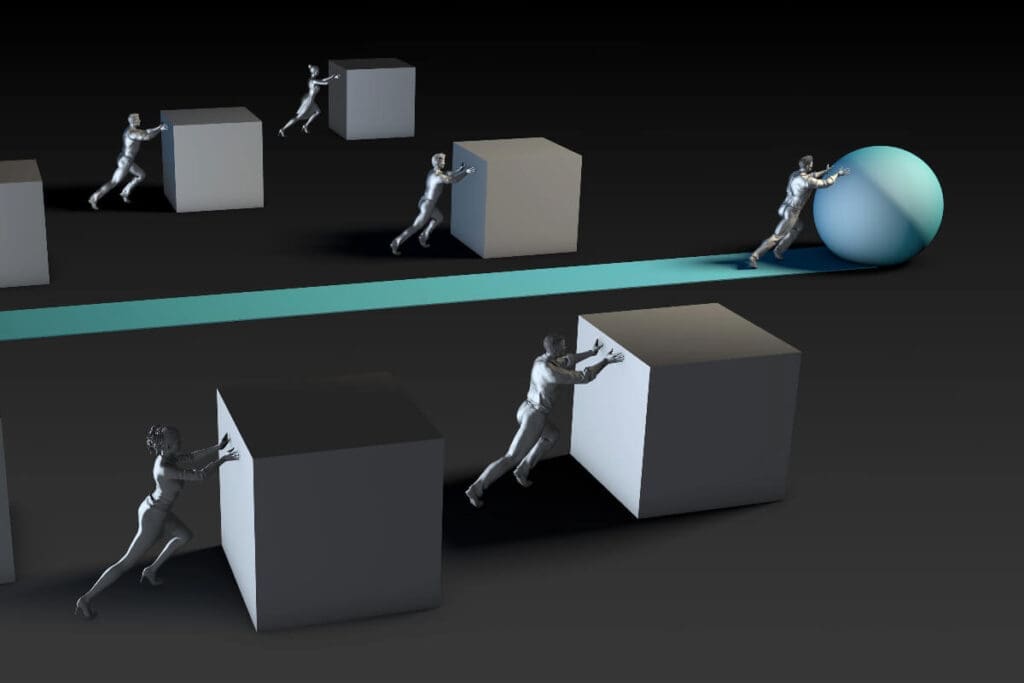Before his untimely death in 2020, I had the privilege of attending a speech by Clay Christensen, the renowned American academic and business consultant. One of his most influential contributions was the theory of disruptive innovation.
According to his theory, disruption starts when a fledgling company identifies a neglected market segment and introduces a new business model or technology that provides a more straightforward, cost-effective, or convenient solution. As time progresses, this innovation gradually shifts from the periphery to capture the attention of mainstream consumers, leading to a significant upheaval in the market.
Table of Contents
- What Is Disruptive Innovation? A Deep Dive Into A Paradigm-Shifting Concept
- Understanding Disruptive Innovation: Beyond Misconceptions
- Real-world Examples: The Case Of Netflix
- Technologies To Watch For Innovative Disruption
- A Dynamic And Nuanced Landscape For Disruptive Innovation
- 12 Ways Disruptive Innovation Drives Importance in Today’s World
- Redefining Markets:
- Making Products Accessible:
- Enhancing Consumer Power:
- Accelerating Technological Progress:
- Economic Growth:
- Environmental Benefits:
- Breaking Monopolies:
- Catalyzing Systemic Changes:
- Encouraging Lifelong Learning:
- Improving Quality of Life:
- Stimulating Investment:
- Fostering Globalization:
- Listen To Our Podcast About Dissecting Disruption: Unraveling the Power of Innovative Transformation Below or By clicking here.
- Related Content
What Is Disruptive Innovation? A Deep Dive Into A Paradigm-Shifting Concept
In business lexicons and startup meetings, “disruptive innovation” is thrown around so casually that its original meaning is often diluted. However, understanding this powerful concept is crucial for startups looking to make a mark and established companies facing the threat of disruption.
Read on as we delve into the essence of disruptive innovation, its implications, and where it stands in the broader landscape of business innovation.
The Origin Of Disruptive Innovation Theory
Coined by Harvard Business School professor Clayton Christensen in the 1990s, disruptive innovation was first introduced in his seminal work “The Innovator’s Dilemma.” The theory aimed to explain how small new entrants can challenge and eventually topple giant incumbents in an industry.
Disruptive innovation begins when a small company targets an overlooked market segment with a new business model or technology that offers a more straightforward, cheaper, or more convenient solution. Over time, the innovation moves from the fringes to mainstream customers, resulting in market disruption.
Understanding Disruptive Innovation: Beyond Misconceptions
Many think disruptive innovation is merely a breakthrough that shakes up existing markets. But the essence of disruption is much more nuanced.
Disruptive innovation isn’t just about technological advancements or immediate changes; it’s a longer-term process that fundamentally alters business models and market landscapes.

The theory often gets reduced to a simple formula: start at the low-end market and move up. While this has often been the case, exceptions like the iPhone and Tesla prove that disruptive innovations can sometimes begin in the high-end market.
What’s crucial is that disruptive innovation is incompatible with the existing business models in an industry, often bypassing traditional routes to reach the consumer.
Why Precise Definition Of Disruptive Innovation Matters?
Some may question why the terminology matters. After all, isn’t any form of innovation good for progress? While true, we must define disruptive innovation precisely to make the theory a practical analytical and predictive model.
A defined process allows us to identify whether an innovation truly has the potential to change industry dynamics or whether it will simply be a sustaining innovation that improves upon existing systems.
Is Disruptive Innovation The Primary Mode Of Innovation?
Contrary to popular belief, most innovation in business is sustaining rather than disruptive. A sustaining innovation enhances existing systems, products, or services and targets demanding, high-end customers.
Disruptive innovation, on the other hand, initially caters to less demanding customers or entirely new customer segments. It’s more of a revolution than an evolution.
Moreover, while disruptive innovation theory provides practical frameworks for analysis, it is not a crystal ball that predicts business success. Established companies have begun to learn the art of being ‘fast followers,’ effectively neutralizing the threats posed by startups.
Real-world Examples: The Case Of Netflix
Netflix is a textbook example of disruptive innovation. Initially, it didn’t appeal to Blockbuster’s core audience.

However, Netflix’s first disruptive step was eliminating late fees with its DVD home delivery model. This was a masterstroke that drew in a specific customer base that was dissatisfied with traditional rental systems.
But Netflix didn’t stop there. They moved on to streaming, eliminating the need for physical stores and appealing to the on-demand nature of contemporary consumers.
This strategy disrupted Blockbuster and compelled Netflix to disrupt itself, showing that disruptive innovation can sometimes be self-inflicted for long-term survival.
Technologies To Watch For Innovative Disruption
Emerging technologies like online learning platforms are noteworthy because they are beginning to disrupt the traditional educational system by making learning accessible and affordable.
While not every innovation leads to disruption, technologies that serve an underserved market and possess the capability to scale could be the disruptors of tomorrow.
Although innovative, autonomous vehicles are more likely to be absorbed into existing industries rather than disrupt them. However, they could re-engineer the broader transportation and logistics sectors.
Alongside technologies like the Internet of Things (IoT) and blockchain, Artificial Intelligence (AI) ranks among the most transformative and disruptive forces.
It has profoundly influenced various industries, including healthcare, business operations, agriculture, educational systems, and urban planning.
In our specific field of being part of the global supply chain, we anticipate numerous disruptive elements that have the potential to fundamentally alter how global supply chain operations function and who the key players in this arena will be.
A Dynamic And Nuanced Landscape For Disruptive Innovation
While “disruptive innovation” has been frequently misapplied, its core tenets remain vital. It forces us to consider how technologies intersect with trapped value in existing systems, offering incremental changes and systemic overhauls.
This transformative impact has made disruptive innovation not just a business theory but a cornerstone of modern entrepreneurial philosophy.
In essence, the theory of disruptive innovation serves as a lens to view the potential trajectories of emerging technologies and business models. While it may not predict future success precisely, it provides a framework for understanding how game-changing advancements can fundamentally alter industry landscapes.
As we move into an increasingly interconnected and rapidly evolving world, understanding and correctly applying the principles of disruptive innovation will be more crucial than ever.
If you want to see how Mondoro can help you manufacture home decor products with a social conscience – we would love to talk to you about how we can help you and be part of your business.
12 Ways Disruptive Innovation Drives Importance in Today’s World
Disruptive innovation – a term popularized by Clayton Christensen – refers to a process wherein a smaller company with fewer resources manages to challenge established incumbent businesses successfully.
These innovations, often deemed inferior initially, gradually upend the market, making them indispensable in the modern world. Here’s why:
Redefining Markets:
Disruptive innovations can potentially create entirely new markets or redefine existing ones. Netflix, for instance, transitioned the home movie-watching experience from DVD rentals to streaming, altering the entertainment landscape.
Making Products Accessible:
Previously expensive and inaccessible products become affordable and available to a broader audience. Consider how personal computers brought computing capabilities from big corporations to homes.
Enhancing Consumer Power:
Disruption often puts more power in the hands of consumers. Platforms like Airbnb or Uber have democratized service access, giving users more choices and control.
Accelerating Technological Progress:
The competition spurred by disruption pushes companies to accelerate their innovations. For instance, the rivalry between iOS and Android platforms has continually driven technological advancements in the smartphone industry.
Economic Growth:
New industries birthed by disruptive innovations contribute to economic growth. They create jobs, inspire new business models, and diversify revenue streams for economies.
Environmental Benefits:
Many disruptive innovations prioritize sustainability. Electric cars like Tesla aim to disrupt the gasoline-powered car industry, leading the charge toward a more eco-friendly transportation future.
Breaking Monopolies:
By challenging established businesses, disruptive innovations prevent the formation of unhealthy monopolies, ensuring that markets remain competitive, dynamic, and customer-centric.
Catalyzing Systemic Changes:
Disruptive innovations can lead to systemic changes in societal norms and behaviors. The proliferation of smartphones, for instance, has revolutionized communication and how we shop bank, and even date.
Encouraging Lifelong Learning:
With the constant advent of disruptive technologies, individuals and businesses must adopt a mindset of continuous learning to remain relevant.
Improving Quality of Life:
Disruptive innovations often address previously unmet needs or simplify complex tasks, improving quality of life. Wearable health monitors, for example, empower individuals to track and manage their health in real-time.
Stimulating Investment:
The potential of a disruptive product to revolutionize a market attracts significant investment. This influx of capital funds further research and development, creating a cycle of continuous innovation.
Fostering Globalization:
Disruptive innovations often have a global impact. They break down geographical barriers, making services and products available across borders. Social media platforms, for instance, have connected people worldwide, reshaping global communication.
Disruptive innovation isn’t just about technology or business but societal progress. It pushes the boundaries of what’s possible, challenges the status quo, and paves the way for a constantly evolving and improving future.
Listen To Our Podcast About Dissecting Disruption: Unraveling the Power of Innovative Transformation Below or By clicking here.

Find out more about how Mondoro can help you create, develop, and manufacture excellent home decor and home furniture products – don’t hesitate to contact me, Anita. Check out my email by clicking here or become a part of our community and join our newsletter by clicking here.
Mondoro gives out a FREE Lookbook to anyone interested. You can receive a copy of our latest Lookbook by clicking here.
Listen to our Podcast called Global Trade Gal. You can find it on all major podcast platforms. Try out to listen to one of our podcasts by clicking here.
Subscribe to our Mondoro Company Limited YouTube Channel with great videos and information by clicking here.
Related Content
Can I Copyright My Furniture Design?
To copyright, your furniture designs a product must be in tangible form. A tangible design has copyright protection but if you want to bring a case to court you must have a registered copyrighted design. The 2010 case of Universal Furniture Vs. Collezione Europa USA gives us a legal precedent.
You can discover more by reading Can I Copyright My Furniture Design? by clicking here.
How Can I Protect My Furniture Designs From Being Copied?
Many designers and furniture companies ask how they can protect their furniture and other designs from being copied. This is a worry of designers and creators everywhere.
You can protect your furniture designs by making sure those you show them have a contract to view them and not copy them; also, make sure the designs are all dated and documented to show they are your original designs.
You can discover more by reading How Can I Protect My Furniture Designs From Being Copied? by clicking here.
Rattan Furniture And Asia and Southeast Asian Colonization
When colonizers came to the new countries, they found materials that they were not used to working with, such as rattan, palm, and bamboo. They used this to create something that can bring comfort to our home, such as chairs to sit on, and they had to start creating an event for furniture that would use local resources and materials.
You can learn more by reading Rattan Furniture And Asia and Southeast Asian Colonization by clicking here.

